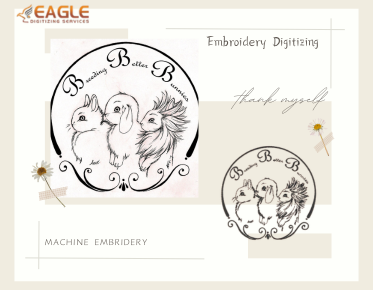How to Extend the Lifespan of Your Embroidery Machine
An embroidery machine is more than just a piece of equipment; it’s the backbone of creativity for many. Whether you’re crafting intricate designs or personalizing items, a well-maintained machine ensures precision and durability. But like any tool, it demands care and attention. When neglected, its performance falters, creativity suffers, and frustration mounts. Nurturing your machine can save you from costly repairs and unnecessary stress. Let’s explore how to keep your embroidery machine in its prime for years, ensuring it remains your most trusted creative partner.
Why
Your Embroidery Machine Deserves Extra Care
Think of your embroidery machine as a finely tuned instrument. It
thrives on precision, and neglect can quickly derail its performance. Without regular
maintenance, even the best machines can fall victim to wear and tear,
compromising their ability to deliver flawless stitches. A well-cared-for
machine operates smoothly and inspires confidence in your craft. By taking the
time to ensure its upkeep, you protect your investment and enhance your
creative experience, allowing your artistry to shine without interruptions.
The
Hidden Costs of Neglecting Your Embroidery Machine
Skipping maintenance may save time in the short term, but it’s a false
economy. Frequent breakdowns, costly repairs, and even premature replacement
can wreak havoc on your wallet. Beyond financial losses, neglecting your
machine can lead to uneven stitching, ruined designs, and wasted materials. The
frustration of dealing with constant malfunctions can dampen your enthusiasm
for embroidery. Taking proactive steps to care for your machine can help you
avoid these pitfalls, ensuring it continues to bring your creative visions to
life.
How Long Should an Embroidery Machine Last
With
proper care, a high-quality embroidery machine can last a decade or more.
However, lifespan varies based on usage, maintenance, and the materials used. A
hobbyist’s machine may last longer than one used in a high-demand production
setting. By understanding the potential lifespan, you can plan for regular
upgrades or repairs while making the most of your current machine’s capabilities.
With diligent care, you can often extend its usefulness far beyond manufacturer
expectations.
Key Factors That Impact
Durability
The materials you use, the frequency of operation, and even your work
environment can influence your machine’s longevity. Dust and lint can
accumulate in the internal mechanisms, causing friction and damage over time.
Cheap threads and inferior fabrics can lead to frequent jams, while overuse can
strain the motor. Paying attention to these details helps you avoid unnecessary
wear and tear. Your machine’s durability is as much about how you treat it as
it is about its build quality.
Daily
Habits for a Healthier Embroidery Machine
Cleaning Like a Pro: Daily and
Weekly Routines
A little cleaning goes a long way. Remove lint and dust after each
session, especially around the bobbin case and feed dogs, where debris tends to
accumulate.To get into confined areas, use compressed air or a tiny brush.
Weekly, wipe the exterior and check for loose threads or buildup that might
hinder performance. Regular cleaning not only prevents malfunctions but also
ensures your machine operates with precision, allowing you to focus on your
projects.
Avoiding Overload: Know Your
Machine’s Limits
Pushing your machine beyond its capabilities can lead to overheating
and premature wear. Every embroidery machine has its limits, outlined in the
user manual. Stick to recommended usage guidelines and avoid overloading it
with thick fabrics or dense designs that it wasn’t built to handle. By
respecting its limits, you reduce stress on its components, allowing it to
operate efficiently and last longer.
The Right Threads and Fabrics
for Machine Longevity
Not all threads and fabrics are created equal. Cheap threads often
fray, snap, or shed lint, which can cause jams and wear out internal parts
faster. Opt for high-quality, compatible materials to ensure smooth operation.
Similarly, using fabrics that are too thick or coarse for your machine can
strain its motor and needles. Investing in the right materials protects your
machine and improves the quality of your creations.
Maintenance
Must-Haves
The Magic of Regular Oiling and
Greasing
Friction is the enemy of any mechanical system. Regular oiling and
greasing at recommended intervals ensure smooth operation by reducing wear on
moving parts. Always use the lubricant specified by the manufacturer, as
generic alternatives can damage your machine. A well-lubricated machine not
only operates quietly but also performs with the precision needed for intricate
embroidery work.
When to Schedule Professional
Tune-Ups
Even with diligent care, professional servicing is essential. A
technician can address the wear and tear you might miss, recalibrate the
machine, and replace aging parts. Think of it as a health check-up for your
machine, ensuring it remains in peak condition. Aim for at least one tune-up a
year or more frequently if you use your machine heavily. By being proactive,
you can prevent unplanned malfunctions.
Replacing Worn-Out Parts Before
They Break
Don’t wait for a catastrophic failure. Needles, belts, and other
consumables experience wear with regular use. Inspect them frequently and replace
them as needed. This not only prevents sudden breakdowns but also protects
other components from damage caused by failing parts. Keeping spare parts on
hand ensures you’re never caught unprepared.
Storage
Tips to Keep Your Machine Safe
Protecting Your Machine From
Dust and Moisture
Store your embroidery machine in a clean, dry space to protect it from
environmental damage. Use a dust cover when not in use to prevent lint
accumulation and shield sensitive parts from moisture. If you live in a humid
climate, consider a dehumidifier or silica gel packets to keep the storage area
dry. Proper storage ensures your machine remains ready for use whenever
inspiration strikes.
Smart
Usage Techniques
Mastering the Art of Proper
Needle Changes
Both
your project and your machine may suffer greatly from a dull or bent needle.
Replace needles regularly, ideally after every 8-10 hours of use, or when
switching fabric types. Ensure the needle type matches your project to avoid
unnecessary strain. Proper needle changes not only protect your machine but
also enhance the quality of your embroidery by
delivering cleaner, more precise stitches.
Preventing Thread Tangles and
Jams
Thread jams can strain your machine and ruin your work. Always thread
your machine carefully, following the manual’s guidelines to avoid mistakes.
Use high-quality spools and check for knots or tangles before starting.
Maintaining proper thread tension is equally important to prevent bunching or
looping. These small but effective habits keep your machine running smoothly
and your designs flawless.
The Dos and Don’ts of Hooping
and Unhooping
Improper
hooping can distort your fabric and place undue stress on your embroidery
machine. Always choose the correct hoop size for your project and ensure the
fabric is taut but not overstretched. When unhooping, take care not to tug or
twist the fabric, as this can damage both the material and the machine.
Mastering these techniques preserves your machine’s integrity and improves the
quality of your embroidery.
Tech-Savvy
Tips for Digital Embroidery Machines
Updating Software to Keep Your
Machine Efficient
Software
updates aren’t just about adding new features—they’re essential for fixing bugs
and optimizing performance. Check your manufacturer’s website regularly for
updates and install them promptly. An updated machine runs smoother, processes
design faster, and reduces the risk of glitches during projects. Staying
tech-savvy ensures your machine remains as efficient as the day you brought it
home.
Troubleshooting
Like a Pro
Quick Fixes for Common
Embroidery Machine Issues
Skipped
stitches, broken threads, or alignment problems are common, but they often have
simple solutions. Check the needle and thread for compatibility, rethread the
machine carefully, or adjust the tension settings. Keeping a troubleshooting
guide or your manual nearby can save valuable time. Addressing small issues
promptly prevents them from escalating into larger problems.
How to Spot Serious Problems
Early
Unusual
noises, inconsistent stitching, or frequent errors are clear warning signs. Pay
attention to changes in performance, as they often indicate internal wear or
misalignment. Regularly inspecting your machine for loose screws, worn parts,
or buildup can help you spot potential issues. Early intervention is key to
avoiding costly repairs and prolonging your machine’s lifespan.
When to Call in the Experts
DIY fixes have their limits. If your machine shows persistent problems
or needs a part replacement, it’s time to call in a professional. Attempting to
repair complex issues yourself can worsen the damage. Trusting an expert ensures
your machine gets the care it needs without risking further complications.
Extending
Lifespan Through Smart Investments
Choosing High-Quality
Accessories That Last
Quality
matters, even when it comes to accessories. Invest in durable hoops, presser feet,
and thread cutters that can withstand regular use. Cheap accessories may save
you money upfront, but they can strain your machine and lead to frequent
replacements. High-quality tools protect your machine and make the embroidery process smoother and more enjoyable.
Why Investing in a Backup
Machine Pays Off
If
embroidery is more than a hobby, a backup machine can be a lifesaver. It keeps
your projects on schedule while your primary machine is being serviced or
repaired. A backup also reduces the wear on your main machine by sharing the
workload. While it’s an upfront cost, the long-term convenience and
productivity benefits make it a smart investment.
The Long-Term Benefits of Caring
for Your Machine
A well-maintained machine isn’t just a financial win; it’s a joy to
use. Consistent care preserves its performance, keeps your projects flawless,
and fosters a rewarding creative experience. A reliable machine allows you to
focus on creativity instead of troubleshooting, and it ensures your work
remains polished and professional. The time and effort you invest in
maintenance will pay dividends in the form of stunning designs and a machine
that’s always ready to bring your ideas to life.
Your
embroidery machine is more than just a tool—it’s
a creative ally that deserves your time and attention. With thoughtful care, it
will continue to serve you faithfully, producing stunning designs and enhancing
your craft for years to come. Treat it with respect, and it will reward you
with precision, durability, and inspiration, turning your artistic visions into
reality with every stitch.



